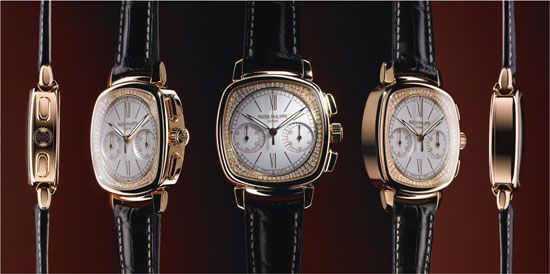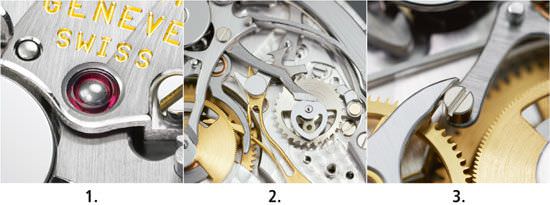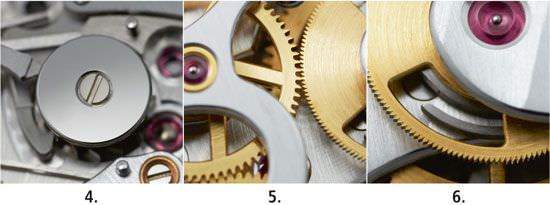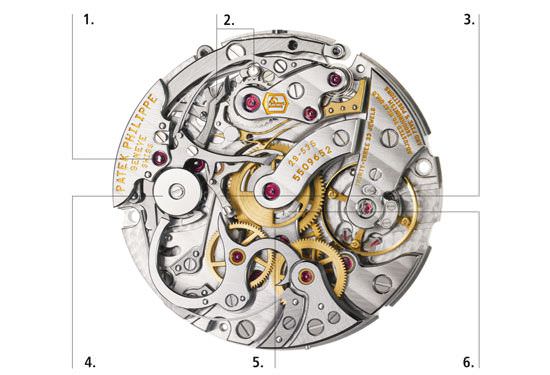In presenting the ‘Ladies First Chronograph’ at the beginning of November in its newly renovated and luxurious boutique on the Place VendÔme at the heart of Paris, Patek Philippe has once again demonstrated its continued pre-eminence in the art of timekeeping.
In his first major public appearance since taking over as President (his father Philippe is now Honorary President), Thierry Stern could not have dreamed of a better occasion for the transition of power. The Ladies First Chronograph is not only a huge success from an aesthetic point of view—and is well on its way to becoming a feminine watch icon—but it is equipped with a brand new manual-winding chronograph movement, the Calibre CH 29-535 PS.
Its name may seem a bit complicated but it makes sense when we realize that ‘CH’ stands for Chronograph, ‘29’ for its diameter (exactly 29.6mm), ‘535’ for its thickness (5.35mm) and ‘PS’ for its ‘Petite Seconde’ hand. And under this appellation lies a magnificent new and very fine chronograph movement, which has taken five years to develop entirely in Patek Philippe’s own ateliers. Intended to replace and surpass the Calibre CH 27-70, based on a Nouvelle LÉmania (part of the Swatch Group) calibre, which had been used up to now by the Geneva brand, this new in-house calibre epitomizes the same grand tradition in timekeeping and technology combined with artisanal finishing.

Back to basics
While the trends of the last few years have favoured spectacular and sculptural tri-dimensional forms, the new Patek Philippe calibre embodies the ultra classic. It features a column wheel crowned with a polished cap, toothed clutch lever system in the form of an S, elegant and refined chronograph wheel bridge and minute-counter bridge, large four-spoke Gyromax balance with four poising weights vibrating at 4 Hz (28,800 oscillations per hour), and a Breguet balance spring. In all, this calibre is composed of 269 component parts, all harmoniously placed in a very restricted space.
Yet under this very traditional appearance—chamfered and polished parts and bridges, decorated with the CÔtes de Genève pattern, with delicately and classically worked surfaces—we find six new patents and pending patents that do not seek to revolutionize watchmaking on the surface but rather to improve its substance. And that makes all the difference.
For the watchmaker and for the user
As for the new and pending patents of the Calibre CH 29-535 PS, they involve the latest advances in a number of details that contribute to a greater understanding of the art of the chronograph. And, these patents not only provide improvement in terms of better energy transmission, reduction in friction, increase in precision and the reduction in vibrations or jumps of the hands, but they also directly ease the work of the watchmaker by permitting better adjustment and therefore greater operational reliability.
One patent provides for an improved penetration adjustment between the clutch and the chronograph wheel thanks to a large ‘eccentric cap’ placed directly on the column wheel. Another patent involves improved synchronization between the clutch lever and the blocking lever, thanks to a finger piece that directly synchronizes both organs. In this way, the watchmaker only has to adjust one point instead of two. This system also eliminates jumps of the chronograph hand when time measurements are started and stopped.
A patented system also involves a self-setting return to zero hammers, thus making it unnecessary for the watchmaker to mechanically adjust the minute hammer function. Still yet another patented advance provides separate jewelled bearings for both the seconds and minutes hammers that pivot on the same axis, each with its own spring, which also improves setting.
Last but not least, the tooth profile of the chronograph mechanism has been optimized in order to increase the efficiency of energy transmission and reduce friction and wear and tear on the movement, while also elimin-ating the risk of hand jump in either direction when starting a measurement. In addition, this new calibre is, unlike its predecessor, equipped with a sophisticated and instantaneous 30-minute counter.
Ladies First Chronograph
For the very first time, Patek Philippe has introduced a new calibre and a new complicated movement in an exclusively feminine model. Clearly the Ladies First Chronograph is a success and is destined to become a brand ‘classic’. Although inspired by the brand’s Art Deco models of the 1930s, the watch’s elegant 18 carat pink gold cushion-shaped case with delicately rounded angles is unmistakably contemporary and immediately recognizable.
Among the features of this new feminine chronograph are the rectangular push-pieces, fluted crown, hinged lugs, bezel set with 136 diamonds, sapphire crystal, silvery opaline or black guillochÉ dial, two off-centred counters decorated with asymmetric scales, the railway track minute scale and its leaf-shaped hour and minutes hands. Together, they delicately reflect the technology of its ‘motorization’ while evoking subtle and sophisticated femininity.
The first watch to be granted the new Patek Philippe Seal, the Ladies First Chronograph inaugurates this new label of excellence with flying colours. And it is only the beginning.


1. Hammers pivoting between jewels. 2. Improved synchronization between the clutchlever and the blocking-lever. 3. Self-setting return to zero hammers. 4. Improved penetration adjustment between the clutch and the chronograph wheel. 5. Optimized tooth profile. 6. Pierced-out minute-counter cam.

Source: Europa Star December-January 2010 Magazine Issue




